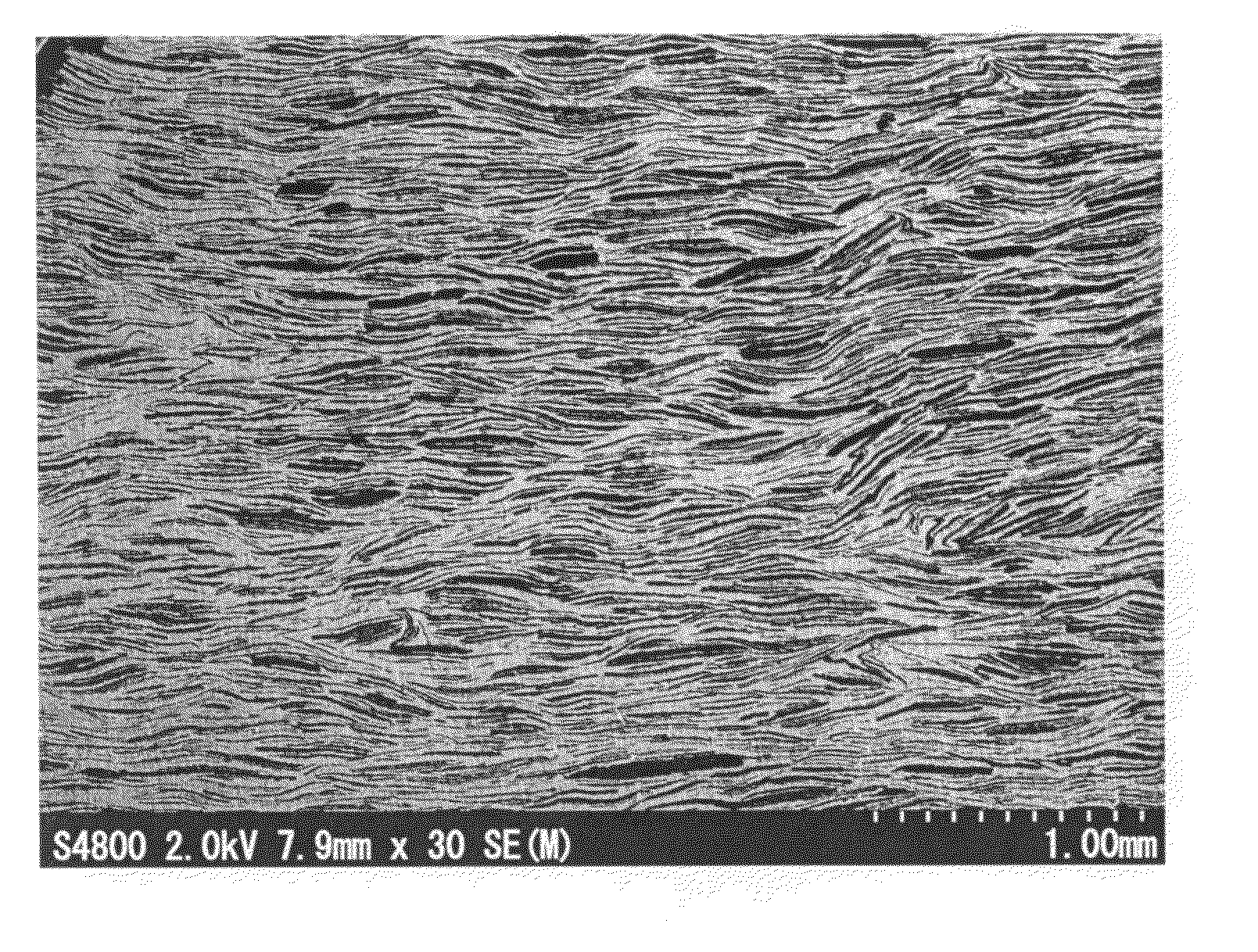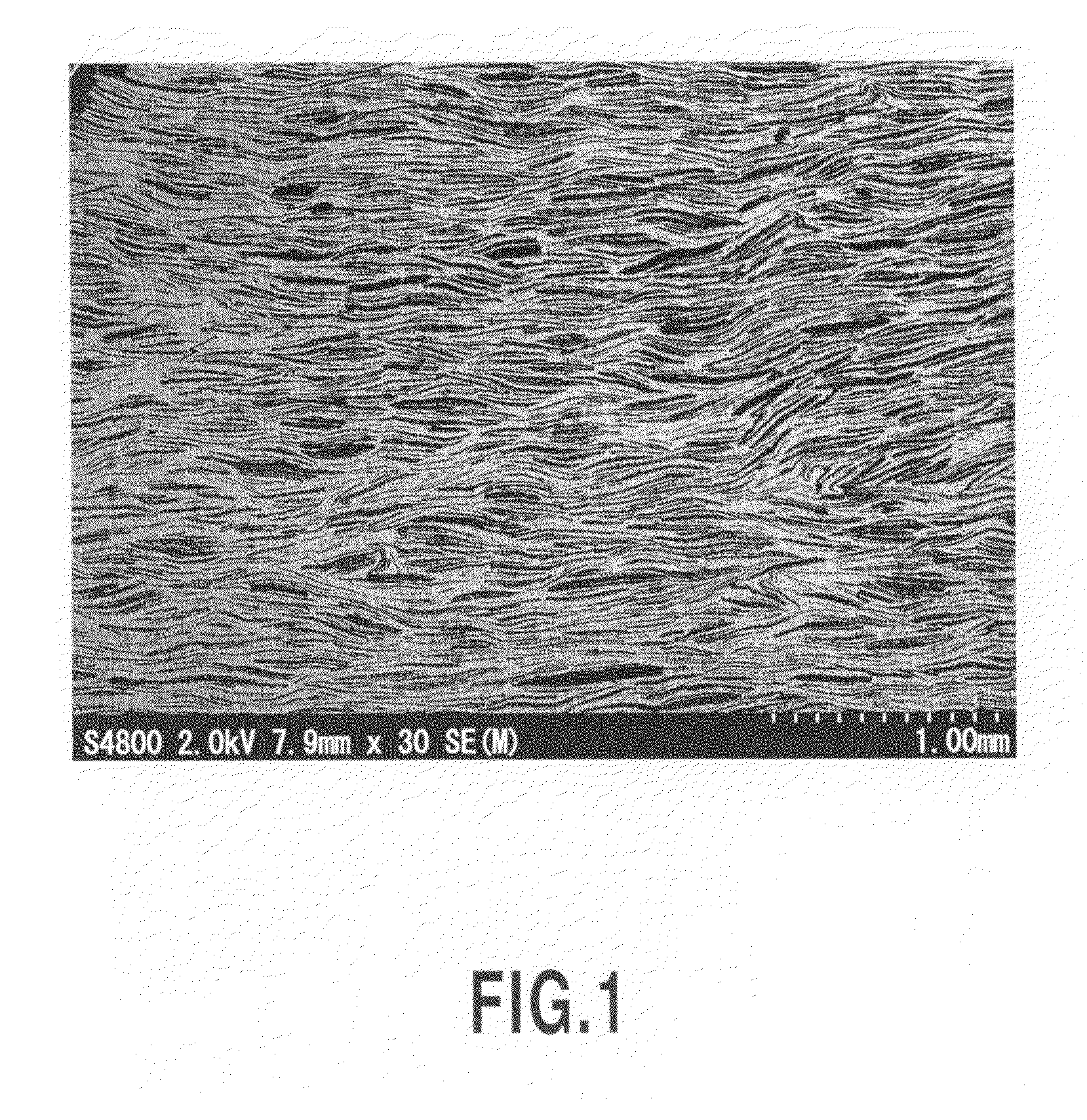Metal-graphite composite material having high thermal conductivity and production method therefor
a graphite and composite material technology, applied in the direction of oxide conductors, non-metal conductors, conductors, etc., can solve the problem that graphite carbon fiber composite materials are unsuitable for diffusing heat two-dimensionally, and achieve low thermal expansion coefficient, efficient cooling of heat of devices requiring cooling, and high thermal conductivity
- Summary
- Abstract
- Description
- Claims
- Application Information
AI Technical Summary
Benefits of technology
Problems solved by technology
Method used
Image
Examples
example 1
[0077]A copper powder used in this Example was a scaly powder having an average particle size of 5 μm and an average thickness of 200 nm. The average aspect ratio thereof was 25, and the true density was 8.93 g / cm3. A graphite powder used in the present invention was a scaly powder having an average particle diameter of 300 μm and an average thickness of 10 μm. The aspect ratio thereof was 30, and the true density was 2.27 g / cm3. The crystallinity of the graphite powder was evaluated by performing the Gakushin method on a sample mixed with 20% by weight of an internal standard silicon powder. As a result, it was revealed that the d002 of the graphite powder was 0.3347 nm, and thus the graphite powder had a high crystallinity.
[0078]Into a planetary ball mill were added 80.2 g of the copper powder, 19.8 g of the graphite powder, 30 g of ethanol, and 300 g of SUS balls having a diameter of 10 mm. The mixing was performed for 10 minutes with the planetary ball mill under conditions at t...
example 2
[0082]A composite material was produced by repeating the procedure in Example 1 except that 73.0 g of the copper powder and 27.0 g of the graphite powder were used when a powder mixture was prepared. The Vf of the obtained composite material was 60%.
[0083]FIG. 2 shows a photograph of a sectional structure of the obtained composite material. Table 1 shows the result of evaluation on the orientation of the graphite powder in the composite material, the evaluation made by observing this photograph of the sectional structure. Table 1 also shows the measurement results of the relative density, thermal conductivity and thermal expansion coefficient of the obtained composite material.
example 3
[0084]A composite material was produced by repeating the procedure in Example 1 except that 63.4 g of the copper powder and 36.6 g of the graphite powder were used when a powder mixture was prepared. The Vf of the obtained composite material was 70%. Table 1 shows the measurement results of the relative density, thermal conductivity and thermal expansion coefficient of the obtained composite material.
PUM
| Property | Measurement | Unit |
|---|---|---|
| particle size | aaaaa | aaaaa |
| average aspect ratio | aaaaa | aaaaa |
| thickness | aaaaa | aaaaa |
Abstract
Description
Claims
Application Information
 Login to View More
Login to View More - R&D
- Intellectual Property
- Life Sciences
- Materials
- Tech Scout
- Unparalleled Data Quality
- Higher Quality Content
- 60% Fewer Hallucinations
Browse by: Latest US Patents, China's latest patents, Technical Efficacy Thesaurus, Application Domain, Technology Topic, Popular Technical Reports.
© 2025 PatSnap. All rights reserved.Legal|Privacy policy|Modern Slavery Act Transparency Statement|Sitemap|About US| Contact US: help@patsnap.com



